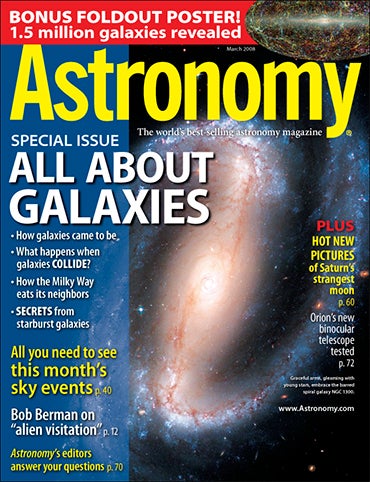
Astronomy‘s mission:
Astronomy promotes the science and hobby of astronomy through high-quality publications that engage, inform, entertain, and inspire.
More resources from Astronomy.com:
- Astronomy news
Astronomy basics
Glossary of astronomical terms
Return to Astronomy “For the media” page
WAUKESHA, WI — The origin of galaxies remains a mystery to astronomers. The only way to solve this conundrum is to look back in time. Astronomers now study galaxies dating as far back as when the universe was less than 1 billion years old.
Richard S. Ellis’ “Quest for the first galaxies” explores new research that is giving astronomers an inside view of how galaxies evolved. Galaxies are the easiest components to spot in our universe. With a variety of sizes, shapes, and luminosities, astronomers want to know how these celestial objects came to be.
The March 2008 Astronomy includes a pullout, four-page, two-sided poster that maps the cosmic web of 1.5 million galaxies within the local universe.
“New surveys during the last 5 years are driving an astronomical revolution,” writes Ellis. Learn about these new discoveries in the March issue of Astronomy, which arrives on newsstands February 5.
Merging galaxies
Simulations offer a valuable perspective on objects in our universe. New simulations of giant elliptical galaxies show a cycle of mergers, starbursts, and black holes. “What happens when galaxies collide?” by Steve Nadis explores the universe’s grandest constructions with new simulations.
Hungry Milky Way
Our galaxy’s current eminence owes much to a past – and present – spent eating dwarf galaxies. Ray Jayawardhana’s “How the Milky Way devours its neighbors” provides explanations as to how astronomers understand how our galaxy’s formation.
Starburst galaxies
Astronomers are learning that starburst galaxies and their superwinds have much to show us about the evolution of galaxies and why our universe looks the way it does today. “Galaxies on fire” by Astronomy Associate Editor Daniel Pendick explains that the key to understanding the processes that shaped the youngest and most distant corners of the universe is starburst galaxies.
Also in this issue:
- “Exploring Iapetus’ dark side” — Read about Saturn’s strangest moon.
- “Orion’s new binocular telescope tested” — A new design on a classic.
- The March issue of Astronomy also includes Ask Astro, Astro news, Bob Berman’s strange universe, Glenn Chaple’s observing basics, Phil Harrington’s binocular universe, Stephen James O’Meara’s secret sky, The sky this month, New products, and Reader gallery.









